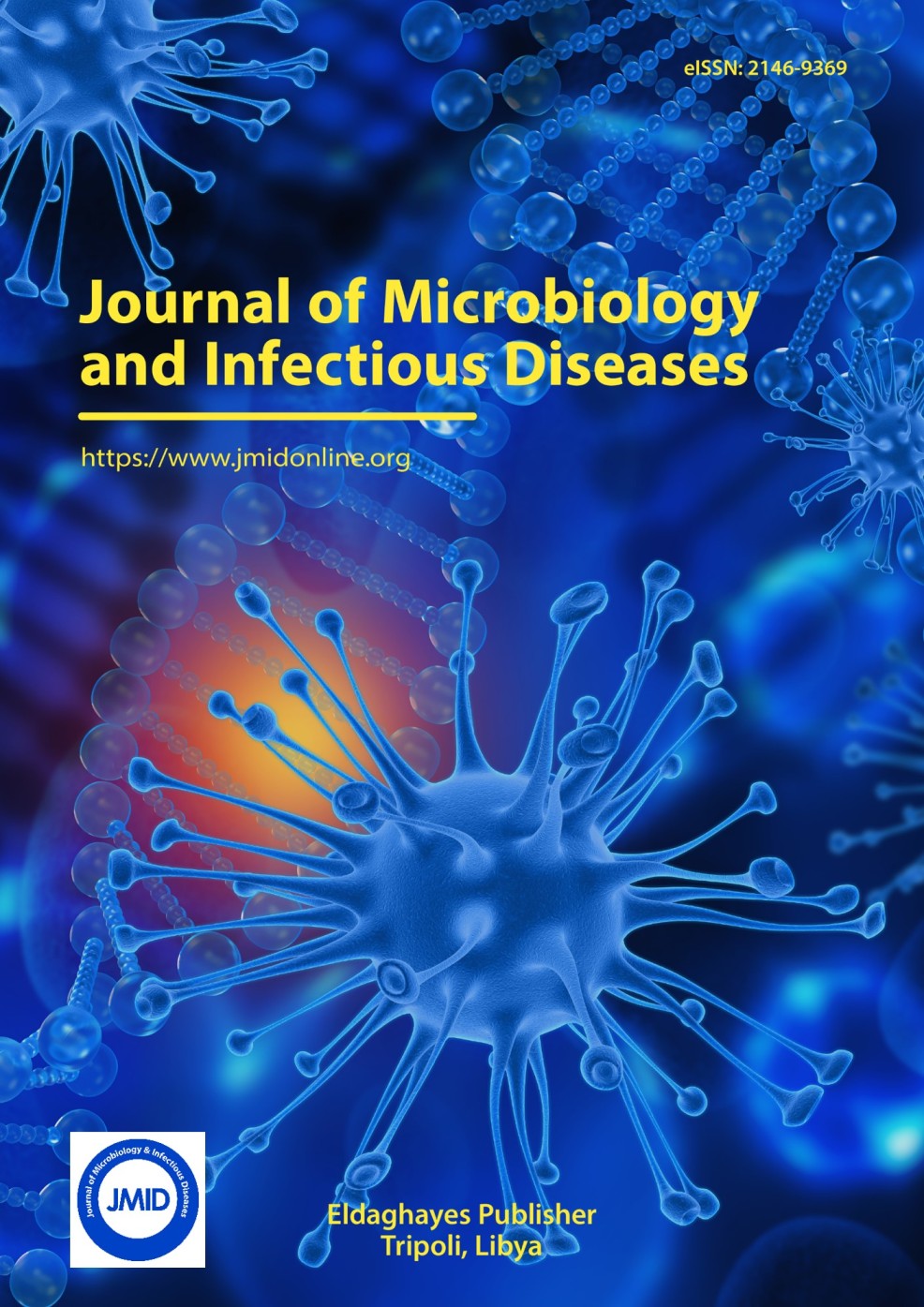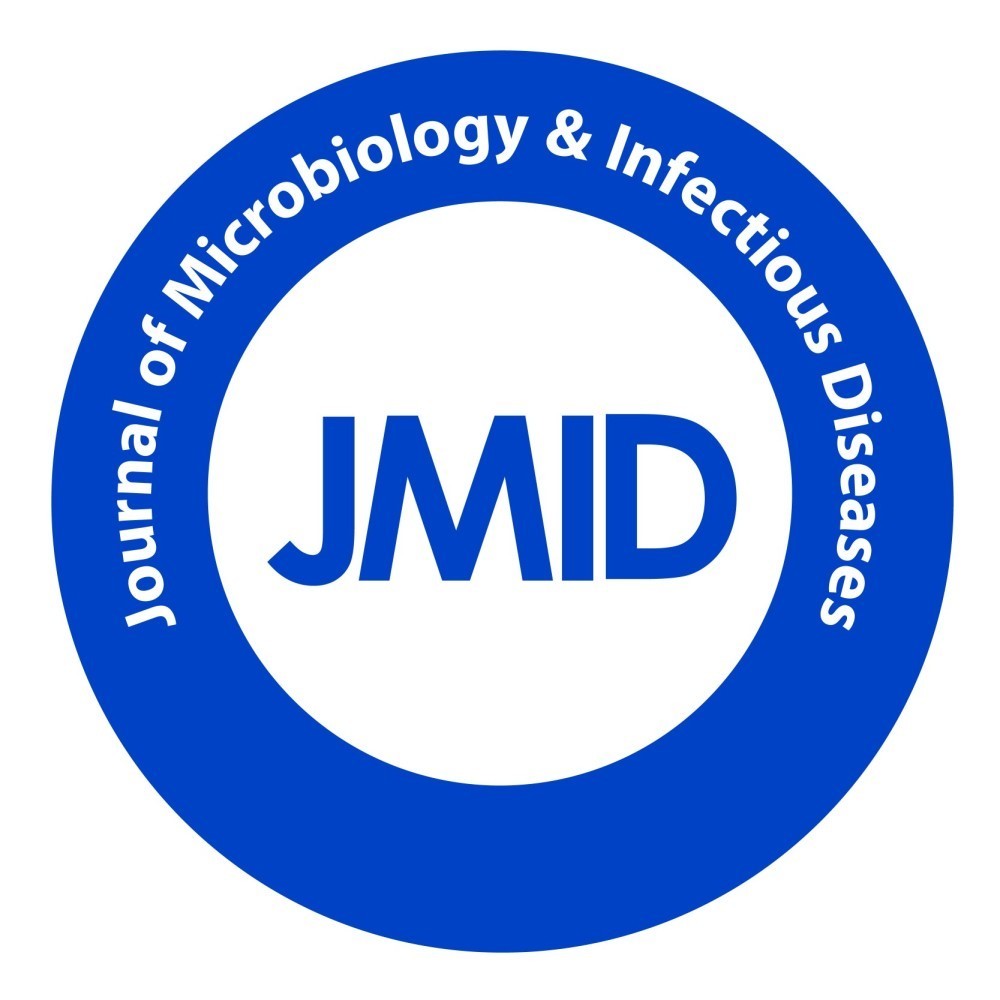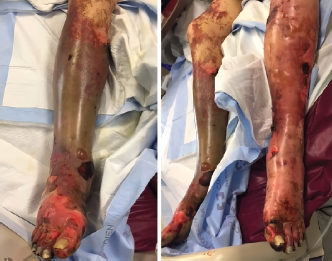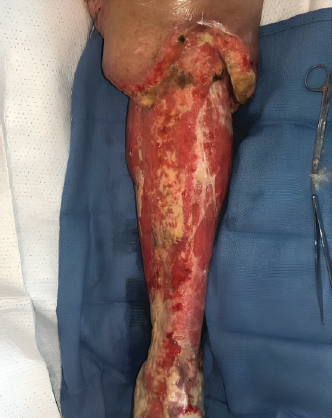
| Review Article | ||
J. Microbiol. Infect. Dis., (2025), Vol. 15(1): 1–4 Review Article Post COVID-19 pandemic surge of fatal streptococcal type 2 necrotizing fasciitis and toxic shock syndrome cases: Review of articlesKannan Subbaram1*, Razana Faiz1, Zeba Un Naher1, Punya Laxmi Manandhar1, Sheeza Ali1, Sina Salajegheh Tazerji2 and Phelipe Magalhães Duarte31School of Medicine, The Maldives National University, Male, Maldives 2Faculty of Veterinary Medicine, Science and Research Branch, Islamic Azad University, Tehran, Iran 3Postgraduate Program in Animal Bioscience, Federal Rural University of Pernambuco (UFRPE), Recife, Brazil *Corresponding Author: Kannan Subbaram. School of Medicine, The Maldives National University, Male, Maldives. Email: kannan.subbaram [at] mnu.edu.mv Submitted: 02/09/2024 Accepted: 04/12/2024, Published: 31/03/2025 © 2025 Journal of Microbiology and Infectious Diseases
ABSTRACTStreptococcus pyogenes is responsible for the severe clinical condition known as type 2 necrotizing fasciitis and toxic shock syndrome (TSS), which are linked to extremely high morbidity and death in both developed and developing countries. It can also be caused by Staphylococcus aureus and S. pyogenes B and G strains. The bacteria rapidly spread into deep tissues, tendons, fascia, and muscles leading to this devastating condition, called type 2 necrotizing fasciitis, from which the bacteria get its name "flesh-eating bacterium". TSS can develop as a result of S. pyogenes infection, typically after the bacteria enter the bloodstream. The bacteria in the bloodstream produce streptococcal pyrogenic exotoxins (A, B, and C). These pyrogenic exotoxins are the cause of streptococcal TSS. TSS and type-2-necrotizing fasciitis patients may have rash, fever, chills, hypotension, necrosis, desquamation, multi-organ failure, and sudden death. Following COVID-19, there was a significant increase in TSS and type-2 necrotizing fasciitis cases around the world. Over 800 instances of streptococcal TSS have been reported in Japan this year alone. The higher prevalence of post-COVID-19 TSS and type-2 necrotizing fasciitis could be related to changed immunological status, a lack of hygiene measures, overcrowding, and enhanced bacterial virulence. Natural COVID-19 infection and COVID-19 vaccination have probably altered the immune status thereby increasing streptococcal TSS cases. Keywords: Toxic shock syndrome, type 2 necrotizing fasciitis, COVID-19, flesh-eating bacteria, Post pandemic, Streptococcus pyogenes. IntroductionStreptococcus pyogenes is a Gram-positive cocci arranged in chains, non-spore forming and non-capsulated bacteria. Streptococcus pyogenes is known to cause a variety of infections ranging from pharyngitis, impetigo, necrotizing fasciitis type 2, toxic shock syndrome, acute glomerulonephritis, rheumatic fever, and so on (Smeesters et al., 2023). Usually, these bacteria are present as normal flora in the throat, skin, gut and vagina. Streptococcus pyogenes is notoriously familiar for its production of various virulent enzymes, exotoxins, and cytotoxins. These virulent factors of S. pyogenes are associated with the enhancement of pathogenesis leading to fatal outcomes (Tae Hyong Kim, 2024). Streptococcus pyogenes are called “flesh-eating bacteria”/necrotizing fasciitis type 2 because of its rapid dissemination from the site of infection to deeper tissues involving severe necrosis in the fascia, muscle, tendons, and connective tissues (Xie et al., 2024). Many cases of fatal streptococcal toxic shock syndrome have been reported around the world. Streptococcus pyogenes is noted for causing auto immune disorders like acute glomerulonephritis and rheumatic fever (Angeliki Mavroidi et al., 2024). After repeated cases of pharyngitis in children, it may predispose rheumatic fever that affects joints and the heart. Streptococcal cutaneous infections like impetigo may lead to acute glomerulonephritis that damages kidneys (Calvo and Jesús Saavedra Lozano, 2024). The laboratory diagnosis for S. pyogenes can be performed by Gram staining, culture on blood agar, catalase test, and test for bacitracin sensitivity. The characteristic features of S. pyogenes include β hemolysis, catalase negative, and bacitracin sensitive. Recently, there were many cases of streptococcal toxic shock syndrome were reported from many parts of the world (Vaclava Adamkova et al., 2024). There are frequent reports of necrotizing fasciitis type 2 were also noticed. These increasing cases of fatal syndromes were observed in post-COVID-19 times. During post-pandemic COVID-19 period, strict adherence to hand hygiene and other sanitary precautions were not followed. Due to these reasons, there is an increased incidence of fatal streptococcal diseases were noticed around the globe. Material and MethodsThis narrative review was performed using Google Scholar, MEDLINE, NCBI, EBSCO, ScienceDirect, SCOPUS, and Web of Science data bases. All the concerned areas of research on Streptococcus pyogenes were retrieved. Detailed literature on streptococcal virulent factors, toxic shock syndrome, necrotizing fasciitis type 2, and other diseases related to this bacterium were collected. The association of streptococcal toxic shock syndrome and necrotizing fasciitis type 2 with post-COVID-19 were also analyzed. We have compared streptococcal TSS and necrotizing fasciitis type 2 syndromes before and after the COVID-19 pandemic to see changing patterns if any. Group A Streptococcus (GAS)Streptococcus pyogenes is classified as GAS under the Lancefield grouping. Streptococcus pyogenes is a Gram-positive cocci, arranged in chains, non-motile, non-capsulated, catalase negative, beta hemolytic, and bacitracin sensitive bacteria. Streptococcus pyogenes is a part of normal flora in various parts of the body particularly abundant in the upper palate, uvula, pharynx, skin, and female genitourinary tract (Armitage et al., 2024). GAS can cause a variety of clinical diseases ranging from pharyngitis, tonsillitis, impetigo, scarlet fever, meningitis, pneumonia, toxic shock syndrome, type 2 necrotizing fasciitis, bacteremia, rhematic fever, and acute glomerulonephritis. Streptococcal toxic shock syndromeToxic shock syndrome (TSS) arises after GAS secrete pyrogenic exotoxins (A, B, and C) in the blood stream. Usually, TSS may occur as a sequalae after type 2 necrotizing fasciitis, bacteremia, or other streptococcal infections. In TSS, the patient may experience sudden fever, rash, hypotension, desquamation, necrosis (Fig. 1), edema, multi organ dysfunction, and rapid death. Immediate diagnosis and treatment are vital in TSS to prevent death (Beatriz Valcarcel Salamanca et al., 2024).
Fig. 1. Severe necrosis, edema, and septic shock produced by Streptococcal toxic shock syndrome (Image courtesy: knowledge AMBOSS). Other etiologic agents associated with TSSOther than GAS, there are other bacteria like Staphylococcus aureus, group B Streptococcus, group G Streptococcus were also connected with fatal cases of TSS. Staphylococcus aureus usually causes a syndrome called tampon toxic shock syndrome may arise after the use of tampons in women. Staphylococcal TSS can occur after cutaneous infection with S. aureus due to the secretion of exotoxin called toxic shock syndrome toxin-1. The mortality rate of staphylococcal TSS was noted to be quite similar to streptococcal TSS (Vieira et al., 2024). Type-2-necrotizing fasciitis (flesh-eating bacteria)Type-2-necrotizing fasciitis is a monomicrobial infection caused by GAS which is a severe and fatal condition. Type-2-necrotizing fasciitis (flesh-eating bacteria) is a rapidly spreading infection involving deep connective tissues, muscle, fascia, tendons, and bones. This infection is characterized by high fever, swelling, necrosis, purulent discharge, and severe abscess. Most often the type-2-necrotizing patient requires amputation otherwise it is fatal. After the COVID-19 pandemic, there were many cases of type-2-necrotizing fasciitis reported across many countries (Enora Atchade et al., 2024). Post-pandemic surge of TSS due to S. pyogenesAfter the COVID-19 pandemic, it was noted that there was a sharp increase in the cases of TSS caused by S. pyogenes all over the world (Hayama et al., 2024). This has resulted in many deaths in both developed and developing countries (Shen et al., 2023). In the year 2024, in Japan, there were more than 800 TSS cases have been documented (Aminath Shiba Ahmed et al., 2024, Yokota and Kawakami, 2024). In the year 2023, there were around 950 TSS cases were identified. In Britain in the year 2010, there were TSS cases reported due highly toxic strain of S. pyogenes (M1UK), subsequently this strain was noticed in a recent Japan outbreak (Epidemiological Update - Invasive Disease Caused by Group a Streptococci - 21 June 2024). The 2024 Japan TSS cases were observed mostly in elderly patients (over 60 years). The fatality rate of these TSS was noticed to be very high more than 30% among the affected patients (Group A Streptococcal Infections: First Update on Seasonal Activity in England, 2023 to 2024). Sweep of TSS and type-2-necrotizing fasciitis during post-COVID-19The main reason for the sweeping cases of TSS and type-2-necrotizing fasciitis due to GAS was attributed due to the altered immune status after COVID-19 (Group A Streptococcal Infections: Third Update on Seasonal Activity in England, 2023 to 2024). The patients who recovered from COVID-19 exhibited a dramatic change in their immune status because of the generation of cytokine storm (Imperial College London, 2024, Subbaram et al., 2022). Another reason is that the etiologic agent S. pyogenes has attained more virulence, like the M1UK strain (Tadayoshi Ikebe et al., 2024, Iwasaki et al., 2023,Lisandra Nunez Cuello et al., 2024). There were other important cofactors like lack of prevention control measures, improper hand and personal hygiene, and overcrowding also played a vital role in the efflux of TSS and type-2-necrotizing fasciitis (Fig. 2).
Fig. 2. Type-2-necrotizing fasciitis (flesh-eating bacteria) caused by Streptococcus pyogenes (Image courtesy: reddit r/ medizzy, Surgeox). ConclusionGAS is frequently associated with invasive and fatal infections known as toxic shock syndrome and after type 2 necrotizing fasciitis. This is mainly due to pyrogenic toxins secreted by the bacteria which subsequently are released into blood stream. This led to high morbidity and mortality in both developed and developing nations. There is increased incidence following the COVID-19 pandemic, which could be due to altered immune status, ease of hygiene measures, and increased virulence of the pathogen. Though further possible reasons need to be illustrated, early recognition and enhanced treatment would be focused on reducing complications. ReferencesAminath Shiba Ahmed, Kannan Subbaram, Faiz, R., Zeba Un Naher, Punya Laxmi Manandhar, and Ali, S. 2024. Increasing reports of streptococcal toxic shock syndrome from Japan. New Microb. New Infect. 60–61, 101446–101446; doi: 10.1016/j.nmni.2024.101446 Angeliki Mavroidi, Katsiaflaka, A., Efthymia Petinaki, Elisavet Froukala, Papadopoulos, D., Vrioni, G. and Athanasios Tsakris. 2024. M1UK Streptococcus pyogenes causing community-acquired pneumonia, pleural empyema and streptococcal toxic shock syndrome. J. Glob. Antimicrob. Resist. 37, 185–189; doi: 10.1016/j.jgar.2024.03.016 Armitage, E.P., Gabrielle de Crombrugghe, Keeley, A.J., Senghore, E., Camara, F.E., Musukoi Jammeh, Amat Bittaye, Ceesay, H., Ceesay, I., Bunja Samateh, Manneh, M., Kampmann, B., Turner, C.E., Kucharski, A., Botteaux, A., Smeesters, P.R., Silva, Marks, M., Abdul Karim Sesay, and Bah, S. 2024. Streptococcus pyogenes carriage and infection within households in The Gambia: a longitudinal cohort study. Lancet Microb. 5(7), 679–688; doi: 10.1016/s2666-5247(24)00046-6 Beatriz Valcarcel Salamanca, Pascale Renée Cyr, Yngvild Emblem Bentdal, Sara Viksmoen Watle, Astrid Louise Wester, Wikman, M. and Håkon Bøås. 2024. Increase in invasive group A streptococcal infections (iGAS) in children and older adults, Norway, 2022 to 2024. Euro Surveill. 29(20), 2400242; doi: 10.2807/1560-7917.es.2024.29.20.2400242 Calvo, C. and Jesús Saavedra Lozano. 2024. Current epidemiological situation of Streptococcus pyogenes infections. An. Pediatr. Engl. Ed. 100, 161–163; doi: 10.1016/j.anpede.2024.02.006 Enora Atchade, Christian De Tymowski, Grall, N., Tanaka, S. and Philippe Montravers. 2024. Toxic shock syndrome: a literature review. Antibiotics 13(1), 96; doi: 10.3390/antibiotics13010096 Epidemiological update. 2024. Invasive disease caused by group A streptococci—21 June 2024. Available via https://www.paho.org/en/documents/epidemiological-update-invasive-disease-caused-group-streptococci-21-june-2024 Group A streptococcal infections: first update on seasonal activity in England, 2023 to 2024. (n.d.). GOV.UK, London, UK. Available via https://www.gov.uk/government/publications/group-a-streptococcal-infections-report-on-seasonal-activity-in-england-2023-to-2024/group-a-streptococcal-infections-first-update-on-seasonal-activity-in-england-2023-to-2024 Group A streptococcal infections: third update on seasonal activity in England, 2023 to 2024. (n.d.). GOV.UK, London, UK. Available via https://www.gov.uk/government/publications/group-a-streptococcal-infections-report-on-seasonal-activity-in-england-2023-to-2024/group-a-streptococcal-infections-third-update-on-seasonal-activity-in-england-2023-to-2024 Hayama, B., Harada, S., Suzuki, M., Doi, Y., Nomura, Y., Aoki, K., Kazumi Takehana, Tomomi Akatsuchi, Taisuke Enokida, Takeda, K., Seto, A., Mitani, H. and Daisuke Ohkushi. 2024. Outbreak of Streptococcus pyogenes emm89 ST646 in a head and neck surgical oncology ward. Microbiol. Spectrum 12(5), E0426023; doi: 10.1128/spectrum.04260-23 Imperial College London. 2024. Analysis reveals new insights into global surge of Strep A infections | Imperial News | Imperial College London. Imperial News, London, UK. Available via https://www.imperial.ac.uk/news/253233/analysis-reveals-insights-into-global-surge/ Iwasaki, K., Okino, R., Okazaki, A. and Kawashiri, M. 2023. Streptococcal toxic shock syndrome caused by Streptococcus dysgalactiae subsp. equisimilis-related Empyema: a novel case report. Intern. Med. 63(7), 2254–2223; doi: 10.2169/internalmedicine.2254-23 Lisandra Nunez Cuello, Bhattarai, D. and Shin, Y. 2024. A critical case of streptococcal toxic shock syndrome: a case report. Curēus 16(3), e56170; doi: 10.7759/cureus.56170 Shen, X., Liang, H., Wu, G., Chen, M. and Li, J. 2023. A case report of Streptococcus dysgalactiae toxic shock syndrome complicated with symmetric peripheral gangrene. Infect. Drug Resist. 16, 5977–5983; doi: 10.2147/idr.s426930 Smeesters, P.R., Gabrielle de Crombrugghe, Shu Ki Tsoi, Leclercq, C., Baker, C., Osowicki, J., Verhoeven, C., Botteaux, A. and Steer, A.C. 2023. Global Streptococcus pyogenes strain diversity, disease associations, and implications for vaccine development: a systematic review. Lancet Microb; doi: 10.1016/s2666-5247(23)00318-x Subbaram, K., Ali, P.S.S. and Ali, S. 2022. Enhanced endocytosis elevated virulence and severity of SARS-CoV-2 due to hyperglycemia in type 2 diabetic patients. Gene Rep. 26, 101495; doi: 10.1016/j.genrep.2022.101495 Tadayoshi Ikebe, Okuno, R., Yumi Uchitani, Yamaguchi, T., Isobe, J., Emi Maenishi, Date, Y., Otsuka, H., Kazawa, Y., Fujita, S., Kobayashi, A., Takano, M., Tsukamoto, S., Kanda, Y., Makoto Ohnishi and Yukihiro Akeda. 2024. Epidemiological shifts in and impact of COVID-19 on streptococcal toxic shock syndrome in Japan: a genotypic analysis of Group A Streptococcus isolates. Int J Infect Dis ; doi: 10.1016/j.ijid.2024.01.021 Tae Hyong Kim. 2024. Toxic shock syndrome (TSS) caused by group a Streptococcus: novel insights within the context of a familiar clinical syndrome. J. Korean Med. Sci. 39, e154; doi: 10.3346/jkms.2024.39.e154 Vaclava Adamkova, Vanda Gabriela Adamkova, Kroneislova, G., Zavora, J., Kroneislova, M., Huptych, M. and Helena Lahoda Brodska. 2024. Increasing rate of fatal Streptococcus pyogenes bacteriemia—a challenge for prompt diagnosis and appropriate therapy in real praxis. Microorganisms 12(5), 995–995; doi: 10.3390/microorganisms12050995 Vieira, A., Wan, Y., Ryan, Y., Li, H.K., Guy, R.L., Papangeli, M., Huse, K.K., Reeves, L.C., Soo, V.W.C., Daniel, R., Harley, A., Broughton, K., Dhami, C., Ganner, M., Ganner, M. A., Mumin, Z., Razaei, M., Rundberg, E., Mammadov, R. and Mills, E.A. 2024. Rapid expansion and international spread of M1UK in the post-pandemic UK upsurge of Streptococcus pyogenes. Nat. Communications 15(1), 3916; doi: 10.1038/s41467-024-47929-7 Xie, O., Zachreson, C., Tonkin-Hill, G., Price, D.J., Lacey, J.A., Morris, J.M., McDonald, M.I., Bowen, A.C., Giffard, P.M., Currie, B.J., Carapetis, J.R., Holt, D.C., Bentley, S.D., Davies, M.R. and Steven. 2024. Overlapping Streptococcus pyogenes and Streptococcus dysgalactiae subspecies equisimilis household transmission and mobile genetic element exchange. Nat. Commun 15(1), 3477; doi: 10.1038/s41467-024-47816-1 Yokota, K. and Kawakami, K. 2024. Efficacy and side-effect profile of tedizolid in the treatment of streptococcal toxic shock syndrome due to clindamycin-resistant Streptococcus pyogenes: a case report. J. Infect. Chemother. 30(8), 785–8; doi: 10.1016/j.jiac.2024.01.002 | ||
| How to Cite this Article |
| Pubmed Style Subbaram K, Faiz R, Naher ZU, Manandhar PL, Ali S, Tazerji SS, Duarte PM. Post COVID-19 pandemic surge of fatal streptococcal type 2 necrotizing fasciitis and toxic shock syndrome cases: Review of articles. J Microbiol Infect Dis. 2025; 15(1): 1-4. doi:10.5455/JMID.2025.v15.i1.1 Web Style Subbaram K, Faiz R, Naher ZU, Manandhar PL, Ali S, Tazerji SS, Duarte PM. Post COVID-19 pandemic surge of fatal streptococcal type 2 necrotizing fasciitis and toxic shock syndrome cases: Review of articles. https://www.jmidonline.org/?mno=218308 [Access: December 06, 2025]. doi:10.5455/JMID.2025.v15.i1.1 AMA (American Medical Association) Style Subbaram K, Faiz R, Naher ZU, Manandhar PL, Ali S, Tazerji SS, Duarte PM. Post COVID-19 pandemic surge of fatal streptococcal type 2 necrotizing fasciitis and toxic shock syndrome cases: Review of articles. J Microbiol Infect Dis. 2025; 15(1): 1-4. doi:10.5455/JMID.2025.v15.i1.1 Vancouver/ICMJE Style Subbaram K, Faiz R, Naher ZU, Manandhar PL, Ali S, Tazerji SS, Duarte PM. Post COVID-19 pandemic surge of fatal streptococcal type 2 necrotizing fasciitis and toxic shock syndrome cases: Review of articles. J Microbiol Infect Dis. (2025), [cited December 06, 2025]; 15(1): 1-4. doi:10.5455/JMID.2025.v15.i1.1 Harvard Style Subbaram, K., Faiz, . R., Naher, . Z. U., Manandhar, . P. L., Ali, . S., Tazerji, . S. S. & Duarte, . P. M. (2025) Post COVID-19 pandemic surge of fatal streptococcal type 2 necrotizing fasciitis and toxic shock syndrome cases: Review of articles. J Microbiol Infect Dis, 15 (1), 1-4. doi:10.5455/JMID.2025.v15.i1.1 Turabian Style Subbaram, Kannan, Razana Faiz, Zeba Un Naher, Punya Laxmi Manandhar, Sheeza Ali, Sina Salajegheh Tazerji, and Phelipe Magalhães Duarte. 2025. Post COVID-19 pandemic surge of fatal streptococcal type 2 necrotizing fasciitis and toxic shock syndrome cases: Review of articles. Journal of Microbiology and Infectious Diseases, 15 (1), 1-4. doi:10.5455/JMID.2025.v15.i1.1 Chicago Style Subbaram, Kannan, Razana Faiz, Zeba Un Naher, Punya Laxmi Manandhar, Sheeza Ali, Sina Salajegheh Tazerji, and Phelipe Magalhães Duarte. "Post COVID-19 pandemic surge of fatal streptococcal type 2 necrotizing fasciitis and toxic shock syndrome cases: Review of articles." Journal of Microbiology and Infectious Diseases 15 (2025), 1-4. doi:10.5455/JMID.2025.v15.i1.1 MLA (The Modern Language Association) Style Subbaram, Kannan, Razana Faiz, Zeba Un Naher, Punya Laxmi Manandhar, Sheeza Ali, Sina Salajegheh Tazerji, and Phelipe Magalhães Duarte. "Post COVID-19 pandemic surge of fatal streptococcal type 2 necrotizing fasciitis and toxic shock syndrome cases: Review of articles." Journal of Microbiology and Infectious Diseases 15.1 (2025), 1-4. Print. doi:10.5455/JMID.2025.v15.i1.1 APA (American Psychological Association) Style Subbaram, K., Faiz, . R., Naher, . Z. U., Manandhar, . P. L., Ali, . S., Tazerji, . S. S. & Duarte, . P. M. (2025) Post COVID-19 pandemic surge of fatal streptococcal type 2 necrotizing fasciitis and toxic shock syndrome cases: Review of articles. Journal of Microbiology and Infectious Diseases, 15 (1), 1-4. doi:10.5455/JMID.2025.v15.i1.1 |










